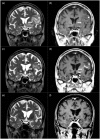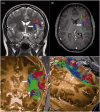Serial magnetic resonance imaging findings of intracerebral spread of listeria utilising subcortical U-fibres and the extreme capsule
- PMID: 27558992
- PMCID: PMC5131762
- DOI: 10.1177/1971400916665384
Serial magnetic resonance imaging findings of intracerebral spread of listeria utilising subcortical U-fibres and the extreme capsule
Abstract
We present a case of Listeria monocytogenes cerebral abscess with axonal spread via the subcortical U-fibres and extreme capsule on magnetic resonance imaging, with follow-up studies demonstrating serial reduction in oedema and enhancement pattern of the white-matter fibre tracts following antimicrobial treatment. We discuss the microbiological mechanism of bacterial mobility to account for these unique imaging features. Recognition of this distinct pattern of spread of L. monocytogenes cerebral abscess may aid in diagnosis and enable early microbiological culture and treatment.
Keywords: Listeria monocytogenes; bacterial neural invasion; cerebral abscess; white-matter fibre tract.
© The Author(s) 2016.
Figures




Similar articles
-
Spreading of multiple Listeria monocytogenes abscesses via central nervous system fiber tracts: case report.J Neurosurg. 2015 Dec;123(6):1593-9. doi: 10.3171/2014.12.JNS142100. Epub 2015 Jun 19. J Neurosurg. 2015. PMID: 26090836
-
[Unusual location of a brain abscess due to Listeria monocytogenes].Pathol Biol (Paris). 2012 Oct;60(5):e45-8. doi: 10.1016/j.patbio.2011.05.006. Epub 2011 Aug 10. Pathol Biol (Paris). 2012. PMID: 21835558 French.
-
Hemorragic presentation of Listeria Monocytogenes rhombencephalic abscess.J Popul Ther Clin Pharmacol. 2020 Jul 16;27(3):e28-e34. doi: 10.15586/jptcp.v27i3.704. J Popul Ther Clin Pharmacol. 2020. PMID: 32757542
-
Brain abscess caused by Listeria monocytogenes: a case report and literature review.Ann Palliat Med. 2022 Oct;11(10):3356-3360. doi: 10.21037/apm-22-383. Epub 2022 Jun 8. Ann Palliat Med. 2022. PMID: 35695050 Review.
-
Multiple cerebral abscesses because of Listeria monocytogenes: three case reports and a literature review of supratentorial listerial brain abscess(es).Surg Neurol. 2003 Apr;59(4):320-8. doi: 10.1016/s0090-3019(03)00056-9. Surg Neurol. 2003. PMID: 12748019 Review.
Cited by
-
Computed tomography and magnetic resonance imaging findings in central nervous system listeriosis.Neuroradiology. 2024 May;66(5):717-727. doi: 10.1007/s00234-024-03313-2. Epub 2024 Mar 4. Neuroradiology. 2024. PMID: 38436702
-
Neurolisteriosis: The Importance of a Prompt Diagnosis.Cureus. 2021 Jul 27;13(7):e16662. doi: 10.7759/cureus.16662. eCollection 2021 Jul. Cureus. 2021. PMID: 34458048 Free PMC article.
-
Early trigeminal nerve involvement in Listeria monocytogenes rhombencephalitis: case series and systematic review.J Neurol. 2017 Sep;264(9):1875-1884. doi: 10.1007/s00415-017-8572-2. Epub 2017 Jul 20. J Neurol. 2017. PMID: 28730571
-
Listeria monocytogenes brain abscesses presenting as contiguous, tubular rim-enhancing lesions on Magnetic Resonance Imaging: Case series and literature review.Neuroradiol J. 2025 Feb;38(1):115-120. doi: 10.1177/19714009241240054. Epub 2024 Mar 17. Neuroradiol J. 2025. PMID: 38494758 Free PMC article. Review.
-
The Tunnel Sign Revisited: A Novel Observation of Cerebral Melioidosis Mimicking Sparganosis.J Radiol Case Rep. 2018 Aug 31;12(8):1-11. doi: 10.3941/jrcr.v12i8.3441. eCollection 2018 Aug. J Radiol Case Rep. 2018. PMID: 30651915 Free PMC article.
References
-
- Clauss HE, Lorber B. Central nervous system infection with Listeria monocytogenes. Curr Infect Dis Rep 2008; 10: 300–306. - PubMed
-
- Crum NF. Update on Listeria monocytogenes infection. Curr Gastroenterol Rep 2002; 4: 287–296. - PubMed
-
- Bojanowski MW, Seizeur R, Effendi K, et al. Spreading of multiple Listeria monocytogenes abscesses via central nervous system fiber tracts: Case report. J Neurosurg 2015; 123: 1593–1599. - PubMed
-
- Perini G, Pravettoni R, Farina E, et al. Listeria brain abscesses during administration of mycophenolate mofetil for systemic lupus erythematosus: A case report. Neurol Sci 2015; 36: 1019–1020. - PubMed
Publication types
MeSH terms
LinkOut - more resources
Full Text Sources
Other Literature Sources
Medical

